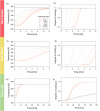Periodic cooking of eggs
- PMID: 39915675
- PMCID: PMC11802719
- DOI: 10.1038/s44172-024-00334-w
Periodic cooking of eggs
Abstract
Egg cooks are challenged by the two-phase structure: albumen and yolk require two cooking temperatures. Separation or a compromise temperature to the detriment of food safety or taste preference are the options. In the present article, we find that it is possible to cook albumen and yolk at two temperatures without separation by using periodic boundary conditions in the energy transport problem. Through mathematical modeling and subsequent simulation, we are able to design the novel cooking method, namely periodic cooking. Comparison with established egg cooking procedures through a plethora of characterization techniques, including Sensory Analysis, Texture Profile Analysis and FT-IR spectroscopy, confirms the different cooking extents and the different variations in protein denaturation with the novel approach. The method not only optimizes egg texture and nutrients, but also holds promise for innovative culinary applications and materials treatment.
© 2025. The Author(s).
Conflict of interest statement
Competing interests: The authors declare no competing interests.
Figures






References
-
- Uysal, R. S. & Boyaci, I. H. Authentication of liquid egg composition using atr-ftir and nir spectroscopy in combination with PCA. J. Sci. Food Agric.100, 855–862 (2020). - PubMed
-
- Galiş, A.-M., Dale, L., Boudry, C. & Théwis, A. The potential use of near-infrared spectroscopy for the quality assessment of eggs and egg products. Sci. Works. C Ser. Veterinary Med.58, 294-307 (2012).
-
- Tarhan, Ö., Gözler, M., Yavuz, R. C. & Şimşek, M. Effect of heat treatment on protein fractions of edible poultry eggs. Akademik Gıda18, 233–240 (2020).
-
- Mine, Y., Noutomi, T. & Haga, N. Thermally induced changes in egg white proteins. J. Agric. food Chem.38, 2122–2125 (1990).
LinkOut - more resources
Full Text Sources
